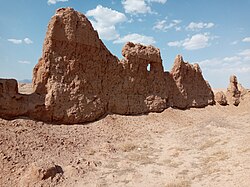 Forg Castle (Mirza Rafi Khan Castle) | |
| Location | Darmian, Iran |
|---|---|
| Region | South Khorasan province |
| Coordinates | 32°50′41″N59°56′55″E / 32.8448°N 59.9485°E |
| Type | Settlement |
| History | |
| Periods | Afsharid era |
| Site notes | |
| Ownership | Mixed public and private |
| Public access | Partial |


Furg Citadel (Arg e Furg, also known as Forg citadel and Mirza Rafi Khan citadel) is an 18th-century citadel located in Furg Village in Darmian County, South Khorasan province, Iran.
Contents
- Name
- Location
- Description
- Section 1
- Section 2
- Section 3
- Tunnel
- History
- Construction
- Qajar era
- European visitors
- Archaeological excavation
- See also
- References
Furg Citadel was constructed by Meerza Muhammad Rafiee Darmiany I (Lama). [1] It was registered in the List of National Works on 18 March 2001.

























